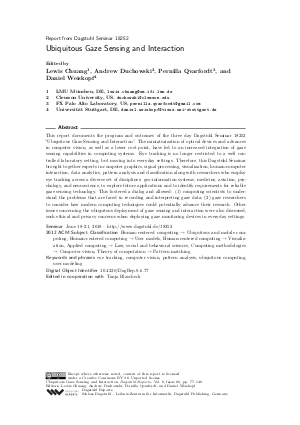Ubiquitous Gaze Sensing and Interaction (Dagstuhl Seminar 18252)
Authors Lewis Chuang, Andrew Duchowski, Pernilla Qvarfordt, Daniel Weiskopf and all authors of the abstracts in this report
-
Part of:
Issue:
Dagstuhl Reports, Volume 8, Issue 6
Part of: Volume: Dagstuhl Reports, Volume 8
Part of: Journal: Dagstuhl Reports (DagRep) - License:
 Creative Commons Attribution 3.0 Unported license
Creative Commons Attribution 3.0 Unported license
- Publication Date: 2019-01-07
File

PDF
DagRep.8.6.77.pdf
- Filesize: 10.44 MB
- 72 pages
Document Identifiers
Subject Classification
Keywords
- eye tracking
- computer vision
- pattern analysis
- ubiquitous computing
- user modeling
Metrics
- Access Statistics
-
Total Accesses (updated on a weekly basis)
0Document
0Metadata
Abstract
This report documents the program and outcomes of the "'. The miniaturization of optical devices and advances in computer vision, as well as a lower cost point, have led to an increased integration of gaze sensing capabilities in computing systems. Eye tracking is no longer restricted to a well controlled laboratory setting, but moving into everyday settings. Therefore, this Dagstuhl Seminar brought together experts in computer graphics, signal processing, visualization, human-computer interaction, data analytics, pattern analysis and classification along with researchers who employ eye tracking across a diverse set of disciplines: geo-information systems, medicine, aviation, psychology, and neuroscience, to explore future applications and to identify requirements for reliable gaze sensing technology. This fostered a dialog and allowed: (1) computing scientists to understand the problems that are faced in recording and interpreting gaze data; (2) gaze researchers to consider how modern computing techniques could potentially advance their research. Other issues concerning the ubiquitous deployment of gaze sensing and interaction were also discussed, such ethical and privacy concerns when deploying gaze monitoring devices in everyday settings.
Cite As Get BibTex
Lewis Chuang, Andrew Duchowski, Pernilla Qvarfordt, and Daniel Weiskopf. Ubiquitous Gaze Sensing and Interaction (Dagstuhl Seminar 18252). In Dagstuhl Reports, Volume 8, Issue 6, pp. 77-148, Schloss Dagstuhl – Leibniz-Zentrum für Informatik (2019)
https://doi.org/10.4230/DagRep.8.6.77
BibTex
@Article{chuang_et_al:DagRep.8.6.77,
author = {Chuang, Lewis and Duchowski, Andrew and Qvarfordt, Pernilla and Weiskopf, Daniel},
title = {{Ubiquitous Gaze Sensing and Interaction (Dagstuhl Seminar 18252)}},
pages = {77--148},
journal = {Dagstuhl Reports},
ISSN = {2192-5283},
year = {2019},
volume = {8},
number = {6},
editor = {Chuang, Lewis and Duchowski, Andrew and Qvarfordt, Pernilla and Weiskopf, Daniel},
publisher = {Schloss Dagstuhl -- Leibniz-Zentrum f{\"u}r Informatik},
address = {Dagstuhl, Germany},
URL = {https://drops.dagstuhl.de/entities/document/10.4230/DagRep.8.6.77},
URN = {urn:nbn:de:0030-drops-100571},
doi = {10.4230/DagRep.8.6.77},
annote = {Keywords: eye tracking, computer vision, pattern analysis, ubiquitous computing, user modeling}
}
